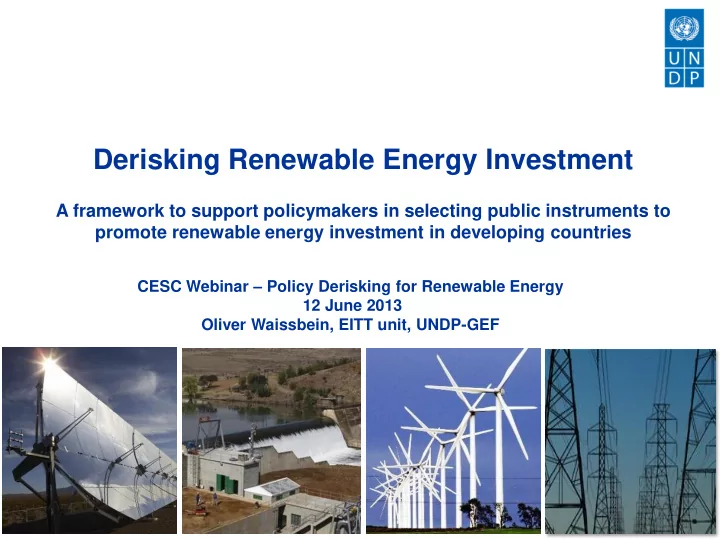

Derisking Renewable Energy Investment A framework to support policymakers in selecting public instruments to promote renewable energy investment in developing countries CESC Webinar – Policy Derisking for Renewable Energy 12 June 2013 Oliver Waissbein, EITT unit, UNDP-GEF 1
Renewable energy vs fossil-fuel energy Developed vs. developing countries Source: UNDP, Derisking Renewable Energy Investment (2013). See Annex A of the report for full assumptions. All assumptions (technology costs, capital structure etc.) except for financing costs are kept constant between the developed and developing country. 2 Operating costs appear as a lower contribution to LCOE in developing countries due to discounting effects from higher financing costs.
Key concepts: Selecting a package of public instruments 3 Source: UNDP, Derisking Renewable Energy Investment (2013).
Key concepts: Public instrument table for renewable energy (Pt 1) 4 Source: UNDP, Derisking Renewable Energy Investment (2013).
Key concepts: Public instrument table for renewable energy (Pt 2) 5 Source: UNDP, Derisking Renewable Energy Investment (2013).
Illustrative case-study - Kenya (1 GW, wind) Risk waterfalls Source: UNDP, Derisking Renewable Energy Investment (2013). Data obtained from interviews with wind investors and developers. See Annex A of the report for full assumptions. 6 The post-derisking cost of debt and equity show the average impacts over a 20 year modelling period, assuming linear timing effects.
Illustrative case-study - Kenya (1 GW, wind) Modeling results LEVELISED COST OF ELECTRICITY 7 Source: UNDP, Derisking Renewable Energy Investment (2013). See Chapter 3 and Annex A of the report for full assumptions.
Derisking Renewable Energy Investment Reports & Financial Tool Available at www.undp.org 8
Derisking Renewable Energy Investment Key take-aways • Theory of change: With technology costs for renewable energy having fallen in recent years, a key opportunity is to address the high financing costs for renewable energy in developing countries. • Some key findings from the report: • The best outcomes occur when policymakers address the risks to renewable energy investment in a systematic and integrated way • Investing in derisking measures appears to be cost effective when measured against paying direct financial incentives, such as a feed-in tariff premium 9
Supplementary Slides 10
Key concepts Policy vs. financial derisking Source: UNDP, Derisking Renewable Energy Investment (2013). 11
Illustrative casestudy – South Africa (8.4 GW, wind) Risk waterfalls Source: UNDP, Derisking Renewable Energy Investment (2013). Data obtained from interviews with wind investors and developers. See Annex A of the report for full assumptions. 12 The post-derisking cost of debt and equity show the average impacts over a 20 year modelling period, assuming linear timing effects.
Illustrative casestudy – South Africa (8.4 GW, wind) Modeling results LEVELISED COST OF ELECTRICITY 13 Source: UNDP, Derisking Renewable Energy Investment (2013). See Chapter 3 and Annex A of the report for full assumptions.
Recommend
More recommend